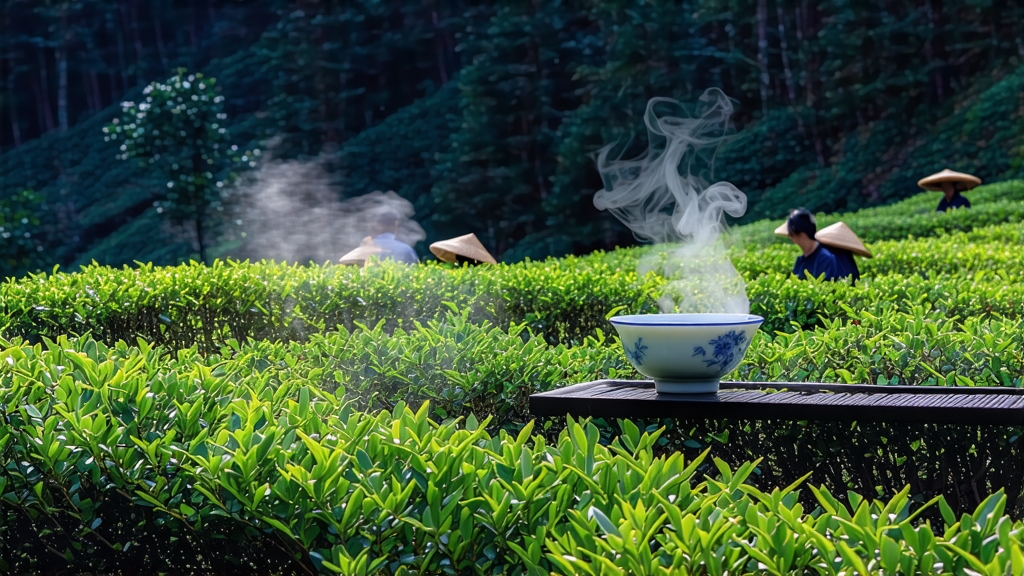
Floating above the Tropic of Cancer, the Alishan range catches moisture-laden clouds that roll in from the Taiwan Strait. Those clouds act as a natural shade-cloth, slowing leaf growth and coaxing the bush into storing more amino acids and fragrant oils. The result is Alishan High-Mountain Oolong, a tea that international judges now rank alongside Darjeeling and Uji Gyokuro for sheer aromatic complexity, yet one that remains rooted in a distinctly Chinese oolong tradition transplanted across the strait.
1. Historical Footprints
Oolong itself was born in Fujian during the Ming-Qing transition, when farmers learned to “shake-green” leaves in bamboo baskets, bruising edges just enough to let oxygen tint the leaf rim copper while the heart stayed green. Migrants from Anxi and Wuyi carried these techniques to Taiwan in the late 18-th century, but it was not until the 1980s that the Taiwanese Tea Research and Extension Station released the modern “qing xin” (green-heart) cultivar suited to elevations above 1,000 m. Alishan, once a logging railway terminus, turned into a tea frontier; within two decades its amber liquor went from mountain cafeterias to Parisian tearooms, rebranding Taiwan as the island of high-mountain oolong.
2. Terroir in the Cloud Belt
Alishan is not a single peak but a 20-km ridge whose red lateritic soil is laced with decomposed granite. Day-night temperature differentials can exceed 15 °C, prompting the plant to thicken cell walls and concentrate geraniol and jasmine lactones. At 1,200–1,500 m the leaves are harvested five times a year, yet the spring and winter flushes—when mist is densest and sunshine softest—yield the most sought-after lots. Locals speak of “yun,” a lingering cool sensation that slides down the throat like minty alpine air; chemists attribute it to the synergy of L-theanine and a unique 3:1 ratio of catechin to epicatechin.
3. From Leaf to Pearl: Crafting Alishan Oolong
Unlike rock oolong that is heavily roasted, Alishan follows the “modern green” style: light oxidation, low roast, maximum fragrance. The 24-hour transformation begins at dawn when pickers pluck the top three leaves and the meristem, keeping the stem intact for later “neck-twisting.” Withering is done outdoors on reed mats for 45 minutes, just long enough for the leaf to lose its grassy edge, then indoors under 22 °C air-conditioning to prevent over-fermentation.
The critical “shaking” phase lasts four cycles; each toss in the tumbling drum is gentler than Anxi’s Tieguanyin, preserving the leaf’s natural pear-shape. Oxidation is arrested at 18–22 % by a 280 °C tumble for 90 seconds—hot enough to kill enzymes yet cool enough to keep chlorophyll from collapsing into blackness. After a 2-hour rest the leaves are wrapped in cotton cloth and compressed into balls, a step repeated 30 times to create the signature “dragonfly-head, toad-tail” pellet. A final 70 °C bake for three hours locks in orchid notes and a whisper of fresh milk.
4. The Dance of Water and Heat
Alishan oolong rewards restraint. A 120 ml gaiwan or a slim-walled zhuni pot allows heat to dissipate quickly, preventing scorch. Use 6 g of tea—about two heaped teaspoons—for every 100 ml of water. Spring water at 95 °C is ideal; anything harder than 80 ppm TDS will flatten the high-register florals. The first 5-second rinse is not discarded but poured over the cups to prime them; the second infusion, 45 seconds, releases a pale champagne liquor with a rim of jade fluorescence. Subsequent steeps add 10 seconds each; a quality Alishan will yield seven infusions before the aroma collapses, the final one tasting of cucumber skin and wet stone.
Western readers often ask whether milk or sugar is permissible. The answer is an emphatic no—casein binds with volatile lactones, erasing the very milky illusion that nature has already woven into the leaf.